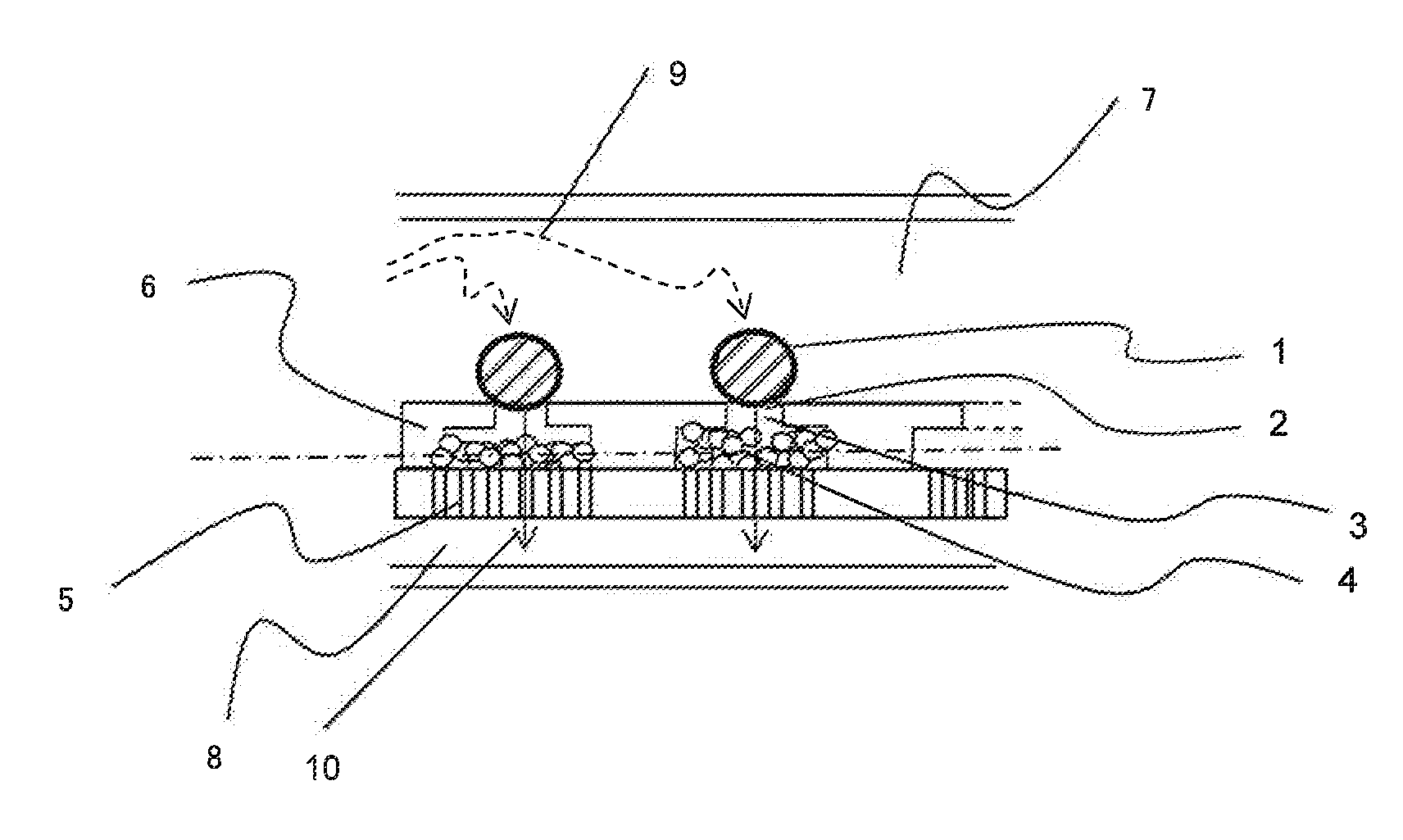Two-Dimensional Cell Array Device and Apparatus for Gene Quantification and Sequence Analysis
a cell array and gene quantification technology, applied in combinational chemistry, dna preparation, library creation, etc., can solve the problems of increasing size and the cost of the analyzer, and the cost of reagents is very high, so as to achieve efficient treatment of molecules and increase the number of cells
- Summary
- Abstract
- Description
- Claims
- Application Information
AI Technical Summary
Benefits of technology
Problems solved by technology
Method used
Image
Examples
example 1
[0072]This example relates a device for nucleic acid extraction in which a nucleic acid trapping section is constructed by packing a lot of DNAs (DNA probes) for nucleic acid trapping which are immobilized on beads, and an apparatus for sample treatment.
[0073]The basic constitution of the unit structure of the device for nucleic acid extraction in this example is the same as that shown in FIG. 1. However, the device in this example is constituted to be capable of constructing cDNA library, in addition to extracting nucleic acid from cells and capturing mRNA, and using it as a template, this device makes it possible to obtain a sufficient amount of nucleic acid amplification products having known sequences at the terminuses that can be subjected to sequencing.
[0074]FIG. 3(a) shows a cross section of a unit structure for treating a single cell in the device for nucleic acid extraction corresponding to this example. FIG. 3 and FIG. 4(b) to (f) show concepts of steps that can be perform...
example 2
[0099]In this example, a porous array sheet on which DNA probes are immobilized is used as the nucleic acid trapping section instead of a device for nucleic acid extraction comprising a bead-based nucleic acid trapping section, in order to construct a cDNA library of cells aligned in the form of an array while retaining the information concerning the cell origins of mRNAs contained in each cell. After the cDNA library is constructed, nucleic acid amplification is not carried out via PCR amplification, but nucleic acid amplification is carried out with the use of a T7 promoter.
[0100]FIGS. 7, 8, and 9 show the structure of the device for nucleic acid extraction used in this example and the method of extraction and treatment using the same.
[0101]FIG. 7(a) shows a cross section of a unit structure of the device for nucleic acid extraction. Cells 1 are captured (trapped) by the cell trapping section 2 by allowing a cell-containing buffer solution to flow through the device from the upper...
example 3
[0113]The device for nucleic acid extraction that implements single-cell gene analysis is capable of identifying individual properties / conditions of cells. In contrast, non-invasive microscopic observation is capable of assaying configurations and chemical compositions of cells while the cells remain alive. However, it has been very difficult to identify cellular conditions based only on the information obtained by microscopic imaging because individual properties / conditions of cells are diverse and unstable. In this example, the constitutions of the device and the apparatus that implements identification of individual properties of cells via single-cell gene analysis in combination with non-invasive imaging are described. When microscopic observation is performed while capturing cells with the use of the device as shown in FIG. 3(a) or FIG. 7(a), in general, the refractive index of a transparent material constituting beads or porous sheets is different from that of a solution. Acco...
PUM
| Property | Measurement | Unit |
|---|---|---|
| volume | aaaaa | aaaaa |
| volume | aaaaa | aaaaa |
| temperature | aaaaa | aaaaa |
Abstract
Description
Claims
Application Information
 Login to View More
Login to View More - R&D
- Intellectual Property
- Life Sciences
- Materials
- Tech Scout
- Unparalleled Data Quality
- Higher Quality Content
- 60% Fewer Hallucinations
Browse by: Latest US Patents, China's latest patents, Technical Efficacy Thesaurus, Application Domain, Technology Topic, Popular Technical Reports.
© 2025 PatSnap. All rights reserved.Legal|Privacy policy|Modern Slavery Act Transparency Statement|Sitemap|About US| Contact US: help@patsnap.com



